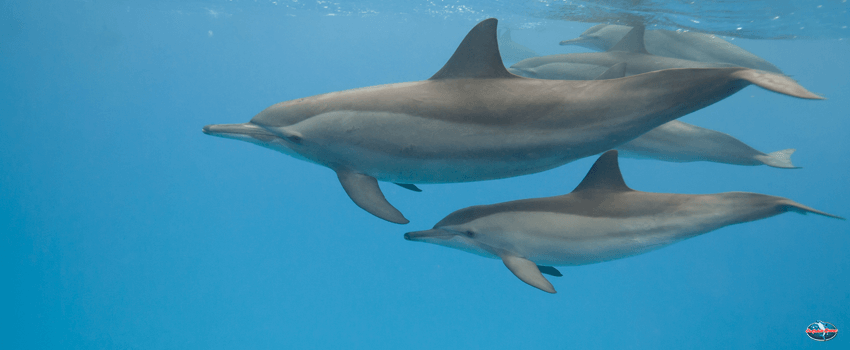Our marine ecosystem plays host to a multitude of various creatures. Large and small, fish, mammals, crustaceans, and more call the ocean home. Of these, the intelligent dolphin is known far and wide for its playful, curious nature. But what distinguishes dolphins from their marine neighbors? Are dolphins fish, or are they something else? By learning about dolphins and understanding the many characteristics of dolphins, we can uncover facts about dolphins. This can give us keen insight into the world beneath the waves.
Dolphins Produce Milk
Believe it or not, dolphins are mammals, just like us. The main features of mammals are their mammary glands that produce milk. Female dolphins lactate and feed their young through their mammary slits that are found on either side of their genital slits. Dolphins may also produce milk while pregnant, allowing them to feed their older calf until the next one is born. Most dolphin calves nurse between two and four years, and some may stay with their mothers for up to five years.
Dolphin milk is not similar to human milk but is closer to the high-fat milk that dogs and reindeer produce; however, it doesn’t have a lot of lactose compared to dog and reindeer milk.
Dolphins Don’t Have Gills
Another thing that makes dolphins different from fish is their lack of gills. Dolphins, like other mammals, have lungs for breathing. They take a breath when you see them emerge from the depths now and again. Instead of noses, dolphins have a blowhole through which they inhale and exhale. When you see them on the water’s surface, you’ll see them spray water from their blowholes. This water isn’t from their lungs. It comes from the water coming off their bodies; it’s much like blowing your nose when you come up to the water’s surface after a dive.
This blowing action allows dolphins to inhale air without inhaling water. They also only breathe through their blowhole and not through their mouths, allowing them to breathe while they eat.
Dolphin lungs are collapsible, which helps them avoid decompression sickness. This also allows them to breathe faster than humans. Studies suggest that a dolphin can replace up to 95 percent of the air in their lungs; we humans can only replace up to 65.
Dolphins are Warm-blooded
All mammals are warm-blooded; they maintain their core body temperatures regardless of their environment’s temperature. On the other hand, fish, reptiles, and amphibians are cold-blooded. Their bodies’ temperatures reflect the temperature of the water they live in. Birds are also warm-blooded, but they’re in a whole class of their own.
Instead of hair, dolphins and other marine mammals have a protective layer of blubber to keep them warm and maintain their temperatures. It also streamlines their bodies and reduces drag. However, baby dolphins have hair on their bodies when they are born. They shed the hair soon afterward but keep their hair follicles and a few tiny hairs near their blowholes into adulthood.
Tampa Bay’s resident dolphins enjoy warmer temperatures than most other areas. Owing to its connection to the Gulf of Mexico, dolphins spotted at John’s Pass are slimmer than their Atlantic cousins. In the open ocean, dolphins must consume large quantities of fish and other prey to build a thick, protective layer of blubber.
One of the fun facts about dolphins, in particular our resident dolphins in Tampa Bay, is their speed. Blubber plays an essential role in a dolphin’s swiftness. It is concentrated and rigid near the tail, acting like a spring to propel a dolphin through the water. If you also watch close enough, you’ll also notice that dolphins move their tails up and down, unlike fish, which move their tails left and right.
Baby Fish, Baby Dolphins
Learning about dolphins and their ways will often prove that we have more in common than we expected. Among other facts about dolphins that people wonder about is how they have their babies. It may surprise you to know that dolphins and human mothers give birth similarly.
A human pregnancy lasts nine months. For a bottlenose dolphin, pregnancy takes 12 months. For dolphins in their entirety, pregnancy ranges from 10 to 18 months. A dolphin will first give birth between the ages of six and thirteen. It will be another two or three years before a dolphin is ready to have another.
Dolphin babies develop inside their mother’s womb, nourished by the placenta connected to the mother’s body via an umbilical cord. This means that, yes, dolphins have belly buttons. They come out of their mother’s womb tail first, unlike other mammals, minimizing the risk of drowning. Until they learn to catch fish, baby dolphins depend on their mother and drink their mother’s paste-like milk.
Meanwhile, fish reproduce in several odd ways, including live birth or eggs. However, fish live births are different than live mammalian births. Fish that have live young retain the fertilized eggs inside their bodies instead of laying them, then expel them fully formed. These babies are known as fry.
Egg-laying fish, such as mackerel, goldfish, and others, are less theatrical. Females release their eggs in a safe, hidden location or open waters, while males release their sperm. Fertilized eggs incubate, then hatch into baby fishes.
Dolphins only give birth to a single calf, while fish produce more babies. Fish babies also have a higher mortality rate than dolphin babies.
Different But Similar
While several characteristics of dolphins would suggest that they are fish, they are, in fact, not. A dolphin is a mammal like the humans that ogle them from piers, boats, and ashore. Both live in the sea and require studious care of the environment to protect their future.
For more facts about dolphins, fish, and all creatures dwelling within Tampa Bay, hop aboard the Dolphin Quest or Shark Boat, the best dolphin cruise in Madeira Beach, for a memorable eco-educational tour. Departing daily from John’s Pass in St. Petersburg, Florida, an expert crew can answer all questions, fishy, mammal-y, or otherwise.
Learn about dolphins and other marine life today.











